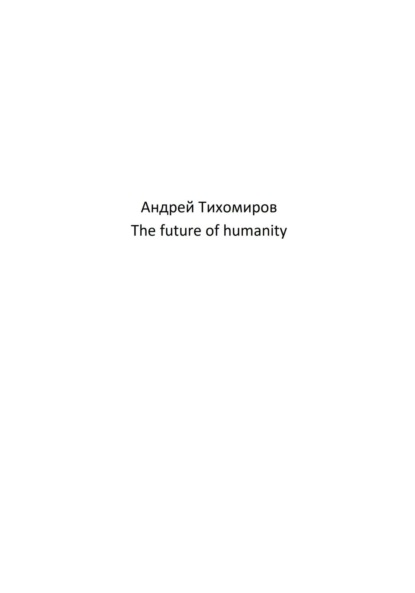По всем вопросам обращайтесь на: info@litportal.ru
(©) 2003-2024.
✖
The future of humanity
Настройки чтения
Размер шрифта
Высота строк
Поля
Андрей Тихомиров
What awaits humanity next? This question is of interest not only to futurologists, but also to the ordinary man in the street. If we briefly describe the entire known history of Homo sapiens, then we can state that this is an eternal struggle for existence, an eternal war with nature, animals, plants and with their own kind.
Андрей Тихомиров
The future of humanity
What awaits humanity next? This question is of interest not only to futurologists, but also to the ordinary man in the street. If we briefly describe the entire known history of Homo sapiens, then we can state that this is an eternal struggle for existence, an eternal war with nature, animals, plants and with their own kind.
To think that there will be something or something else means to fall into illusions. The struggle with oneself is only gaining new turns. The territorial division of the world has been completed, the redistribution of the world between the oligarchs has begun, V. I. Lenin wrote about it at the beginning of the 20th century in his work "Imperialism as the newest stage of capitalism (a popular essay)", published in 1917. Describing the features of the new stage of capitalism, V. I. Lenin noted that "… imperialism is (1) – monopolistic capitalism; (2) – parasitic or decaying capitalism; (3) – dying capitalism." He argued that imperialism represents the highest and last stage of capitalism, after which begins "… the transition from the capitalist to a higher socio-economic order."
Imperialism relied on a higher level of development of productive forces and was characterized by a higher degree of concentration of production and capital, the development of capitalist relations in depth. In order to centrally provide their enterprises with energy, raw materials, transport, finance and labor, monopolies have increasingly resorted to the help of state bodies. As a result, a system of state-monopolistic regulation of the economy began to take shape, which acted in the interests of monopolies, ensuring increased exploitation of workers and infringing on the interests of the petty and middle bourgeoisie. First of all, the main contradiction of capitalism has deepened – between the social nature of production and the private capitalist form of appropriation. This was expressed, on the one hand, in an increase in the production of various goods. Their creation required the coordinated work of millions of workers. This reinforced the social nature of production. On the other hand, as a result of the concentration of capital in the hands of a narrow circle of people, they appropriated most of the goods produced. Private capitalist appropriation took on increasingly ugly forms.
As a result of the deepening of the basic contradiction of capitalism, periodic economic crises of overproduction have become more frequent, prolonged and destructive. In pursuit of profits, the monopolies expanded production even more rapidly and robbed the masses even more mercilessly, who lost the opportunity to buy the goods they produced. In pursuit of profit, the financial oligarchy has accelerated the transfer of huge amounts of capital to the most profitable industries. As a result, with the entry of capitalism into the highest stage, the unevenness characteristic of its development intensified. The increase in the discrepancy between the relations of production and the nature of the productive forces has led to an increase in the uneven development of the economy and politics in capitalist countries. Increasingly, the progress of the productive forces was accompanied by an ideological and political reaction. Actively opposing the restructuring of social relations, she ultimately hindered the development of productive forces. All this deepened and aggravated the contradictions: a) between labor and capital; b) between metropolises and colonies, semi-colonies, and other dependent countries; c) between imperialist states. The contradictions resulted in increasingly large and sharp clashes, wars and "color revolutions", which the big bourgeoisie itself provokes in order to remove unwanted rulers and put puppets.
Imperialism, as V. I. Lenin pointed out, leads "to annexations, to the strengthening of national oppression and, consequently, also to the aggravation of resistance. The peoples of the colonies, semi-colonies and other dependent countries responded to the robbery and exploitation by the financial oligarchy with increased resistance to the colonizers.
Imperialism has led to the strengthening of militarism. This was due to the desire of the financial oligarchy: a) to keep the peoples of the colonies and dependent countries in subjection, b) to expand their possessions and spheres of influence at the expense of other powers, c) to suppress the resistance of workers within their country, and finally, d) to increase their profits through military orders.
Huge funds, the source of which was an increase in taxes from the population, were spent on military purposes. The role of reactionary militarism in politics and ideology has intensified. The cult of power, chauvinism and racism were actively promoted. Armed force was increasingly used to "solve" internal and external problems. Imperialism was characterized by "a special acuteness of the struggle for the redistribution of the world, a special acuteness of clashes leading to wars," wrote V. I. Lenin. Imperialism has given rise to a new type of wars – wars for the redistribution of colonies and spheres of influence, imperialist wars. Having unleashed world wars, imperialism became the culprit of the colossal destruction of productive forces, the death of millions of people. Imperialist states led by their oligarchs divide the world. All this is very similar to the endless wars between gangster clans. Which goes back to the level of the animal world. In the early 30s of the 20th century, the efforts of the Austrian zoologist K. Lorenz (1903-1989) and other scientists laid the foundations of the science of animal behavior, which was called ethology (from the Greek "ethos" – temper, character; the same root in the word "ethics" is the science of human behavior). Nutrition, growth, reproduction and self-preservation correspond to four kinds of instincts: hunger, sexual, aggression and fear. Aggression, according to Lorentz, is a genuine primary instinct aimed at preserving the species. It manifests itself primarily in competition within the species. The fittest individuals can take over a larger territory, bring more offspring and pass on their genes to the next generation. The meaning of intraspecific struggle, firstly, is that "for the species… it is always advantageous for the habitat or the female to be won by the strongest of the two rivals." the "struggle for the female" (mating fights) led to the prohibition of incest (incest) in related communities, a male created a harem of females, other males could not mate with females. When the main male weakened or died, the struggle for power and females began – the scenario was repeated. In many ancient states, for a long time, the custom of physical testing of rulers was preserved – in wrestling, running, etc., if the ruler did not cope with the task, he was killed or removed from power. In ancient Egypt, after a certain time, the ruler had to publicly prove his strength in order to continue to rule, because not only the ability to protect the country from enemies depended on his strength, but, according to the ideas of the time, the productivity of the land, the fertility of livestock, the happiness and prosperity of his subjects, if he could not prove his strength, he was killed and replaced by a younger one. There was until the 17th century the oldest Irish custom – tanistri, according to which, during the life of the king, his successor, a tanist, was elected from a certain noble family. This is also observed in animals – the weakened leader of the pack is expelled or killed. Each organism has its own territory, which it protects from outsiders, especially from those who occupy the same ecological niche. The boundary of the plots "is determined solely by the balance of forces, and at the slightest violation of this balance, it can move closer to the headquarters of the weakened, at least, for example, if one of the fish has eaten enough and is therefore lazy." "As we approach the center of the habitat area, aggressiveness increases in geometric aggression." The danger of instinct lies in its spontaneity. With a lack of enemies, the threshold of irritation shifts and the animal is ready to show its aggressiveness towards anyone. In other words, the instinct begins to act without the appropriate motivation. A useful, necessary instinct "remains unchanged; but for special cases where its manifestation would be harmful, a specially created braking mechanism is introduced"
The countries of socialism and the Soviet Union did not need wars, since the means of production (factories, factories, land) belonged to the people according to the Constitution, on the contrary, it was peaceful development that showed the advantages of the socialist system over capitalism.
The inherent tendencies of imperialism to parasitism or decay are still manifested today. Firstly, when new inventions or improvements could not be used to immediately increase profits or there was a danger of their use by competitors, monopolies in every possible way prevent their use. This slows down technological progress. Secondly, in the imperialist countries, a layer of rentiers has grown – owners of lent capital, leading an idle life at the expense of rent – income on capital, interest on loans, rent. Rentier states appeared, a significant part of whose income was interest from investments abroad. "The world," wrote V. I. Lenin, "has been divided into a handful of usurer states and a gigantic majority of debtor states." Thirdly, V. I. Lenin called the export of capital "parasitism squared" (now it is called "investment"). It hindered the economic development of the metropolises, gave one-sided development to the economy of colonies, semi-colonies and other dependent countries, depleted their resources. Fourth, due to the huge profits from the exploitation of the colonies, the financial oligarchy overpaid the working aristocracy to strengthen its influence on some of the workers. Fifth, parasitism manifested itself in the increase in the costs of armaments and armed forces. Military orders have become an important additional source of profits for the financial oligarchy. The increase in the means of destruction hindered the development of productive forces and threatened their existence. Despite the increasing trend of decay and parasitism, capitalism as a whole developed faster than before. This led to a further deepening and aggravation of his contradictions.
The further development of the productive forces made it increasingly necessary to socialize production, eliminate private property and exploitation of man by man, that is, the transition to socialism. This was the fundamental interest of all exploited. Such a restructuring of society also meant the destruction of national inequality, in which all oppressed peoples are interested. In addition, it led to the elimination of militarism and wars, from which all mankind suffered.
However, there are many serious obstacles on the way to socialism. The financial oligarchy fiercely resists any social progress. The growing aspiration of the advanced part of the working people to socialism is hindered by the entire bourgeoisie. Under the influence of the bourgeoisie, most of the working people remain, "fed up" with high salaries, both those who supported the bourgeois parties and those who stood aside from the struggle. Imperialism still has huge resources not only of the metropolitan countries of the West, but also of dependent countries entangled in various financial and economic ties.
Overcoming such obstacles requires a truly heroic struggle of all the oppressed, the need to attract the majority of the working people to their side, to rally all progressive forces.
Perhaps once there was a developed civilization on Earth, Mars, and other planets, but everything ended at once when the parties began to use nuclear weapons against each other.
The Curiosity rover recently discovered a hardcover book lying on the surface of Mars. According to skeptics, this is just an ordinary stone. At the same time, some of the researchers saw the pages of the object and a completely distinguishable font. The NASA image was taken on the 3800th day of the device's stay on the Red Planet. In order to take a picture, the car had to stop and use a manipulator, at the end of which there is a camera with a customizable lens. The nature of the discovered "book" is not yet fully clear.
Perhaps these ancient drawings depict not alien astronauts, but people from advanced cultures in protective suits-overalls, so as not to infect and not to get infected themselves. From books: The Great Soviet Encyclopedia, editor-in-chief S.I. Vavilov, The State Scientific Publishing House "The Great Soviet Encyclopedia", vol. 1, 1949, Hefling G., All the "miracles" in one book, M., "Progress", 1983
Two ancient bronze Japanese figurines. The big one (on the right) is almost 60 centimeters tall. It appears that their heads are wearing helmets with holes for breathing. Some believe that these are intercom devices. The "glasses" of an astronaut or modern epidemiologists are also striking.
A fresco from Sefar (the Sahara region near Tassili). At the top is a figure resembling a diver or a doctor in a special suit. Below is a "Martian" or a man in a protective suit.
On the left: the figure of a priest from Val Camonica (Northern Italy). isn't he a doctor with an antenna on his head? In the middle: an image of a priest from Inyo County from California, maybe also in a protective suit? On the right: "cosmonaut doctor" from rock paintings in Val Camonica.
A round "spaceship" on a cult object from Mexico. Isn't the moment of the cosmonauts' arrival on Earth depicted here? Among the "technical accessories" animals, flowers, fruits are distinguishable.
This white-bordered light yellow figure measuring 180x140 centimeters seems to be dressed in a tight-fitting special suit with handlebars on the shoulders and antenna pins on a protective helmet.
"The Great God of the Martians" from Jabbaren, Tassili. Or a man in a special suit?
This fresco from Jabbaren, Tassili, was hidden under a dense layer of slate dust. Is it possible to say that the huge figures depicted on it are dressed in special overalls? Some experts believe that there are drawn arrows from the bow with tufts of feathers on the head.
On the left: drawings of Australian aborigines. On the right: the image of the Japanese "kappa", or "reed man" – 8th century A.D. There are many legends about him. He allegedly could fly through the air at an incredible speed.
The mysterious "warrior of Teotihuacan". His helmet is equipped with holes for the eyes; a tight-fitting suit and unusual shoes strangely resemble the equipment of an epidemiologist.
Drawings of Australian aborigines on a rock dressed in protective suits resembling figures.
Images of a helicopter, an airplane, a submarine in the temples in Karnak and Abydos, Ancient Egypt
Approximately such general directions, acting as much as possible simultaneously, but, at the same time, stand out in their main tasks:
1. The destruction of active pockets of resistance – “chiefdom”, the mechanism of “democracy” is periodically launched in them – bribed opposition, arms supplies, financial and moral support.
2. The dismemberment of the countries of the largest countries in the world (relatively short-term perspective), followed by the dismemberment of all more or less large countries, and subsequently the countries of the West (long-term perspective), so that no state dominates the planet, but only the World Oligarchy.

















